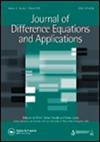Invariant curves in a discrete-time two-species system
IF 1
4区 数学
Q2 MATHEMATICS, APPLIED
Journal of Difference Equations and Applications
Pub Date : 2023-11-09
DOI:10.1080/10236198.2023.2279632
引用次数: 0
Abstract
AbstractThe dynamics of discrete-time two-species systems may not be simple even if they have no positive fixed points. To reveal the behaviour of such systems, we focus on a special class of discrete-time two-species systems whose degenerate cases have a line segment of positive fixed points. As a main result, we show that the line segment of positive fixed points persists as an invariant curve under a small perturbation of the degenerate case. The absence of a positive fixed point ensures that such an invariant curve consists of heteroclinic orbits connecting two axial fixed points. The general result is applied to a discrete-time competition model of Ricker type with reproductive delay. The application reveals the existence of heteroclinic orbits connecting two axial 2-cycles, not only heteroclinic orbits connecting two axial fixed points.Keywords: Heteroclinic orbitinvariant curvecompetition systemRicker map2-cycleMathematic Subject classifications: 92-1092B0539A6039A3037N25 Disclosure statementNo potential conflict of interest was reported by the author(s).Additional informationFundingThis work was supported by JSPS KAKENHI Grant Number 20K03735, Japan.离散时间两种系统的不变曲线
摘要离散两种系统的动力学并不简单,即使它们没有正不动点。为了揭示这类系统的行为,我们研究了一类特殊的离散时间两种系统,它们的退化情况具有正不动点的线段。作为主要结果,我们证明了正不动点的线段在简并情形的小扰动下作为不变曲线存在。正不动点的不存在保证了这样的不变曲线由连接两个轴向不动点的异斜轨道组成。将一般结果应用于具有生殖延迟的Ricker型离散时间竞争模型。应用表明,不仅存在连接两个轴向不动点的异斜轨道,而且存在连接两个轴向不动点的异斜轨道。关键词:异斜轨道不变曲线竞争系统ricker map2-cycle数学学科分类:92-1092B0539A6039A3037N25披露声明作者未报告潜在利益冲突。本工作由日本JSPS KAKENHI基金号20K03735支持。
本文章由计算机程序翻译,如有差异,请以英文原文为准。
求助全文
约1分钟内获得全文
求助全文
来源期刊
CiteScore
2.10
自引率
9.10%
发文量
70
审稿时长
4-8 weeks
期刊介绍:
Journal of Difference Equations and Applications presents state-of-the-art papers on difference equations and discrete dynamical systems and the academic, pure and applied problems in which they arise. The Journal is composed of original research, expository and review articles, and papers that present novel concepts in application and techniques.
The scope of the Journal includes all areas in mathematics that contain significant theory or applications in difference equations or discrete dynamical systems.

 求助内容:
求助内容: 应助结果提醒方式:
应助结果提醒方式:


